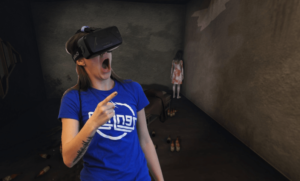VR’s biggest question — How real is too real?
 1) Immersion
1) Immersion
VR is known for its immersive quality, engaging the viewer fully in the film, game or experience. This immersion means that senses and emotions are heightened for the viewer in ways that are not typical to any other medium. A specific example is, when content becomes violent or scary in VR, the viewer can’t simply look away or leave the room. VR content creators can leverage this to engage viewers, immersing them in other worlds, concepts, storylines or, as in advertising and marketing, taking brand awareness to entirely new levels.
2) Cognitive attention
As I mentioned above, VR is the only medium that commands 100 percent of its audience’s attention and requires active watching. This new level of viewer engagement is what really appeals to brands and original content creators. Where ethics fit into this particular aspect is in examining the duration and level of stressful events occurring in any VR experience and the potential psychological implications of such content.
I foresee VR content creators and distributors eventually taking similar precautions that amusement parks do, where a waiver is signed or included in your ticket purchase, relinquishing responsibility for the inherent risks.
3) Ratings
A rating system has been adopted by most VR App stores, led by Oculus. The International Age Rating Coalition (IARC), which assigns age ratings to games and mobile apps, was applied to all VR experiences in March 2017. The implementation of a global rating system across all VR experiences will put the responsibility on consumers to decide what type of content they want to consume or allow others to consume. The standardization takes the pressure off of content creators and leaves it in the hands of consumers.
See the full story here: https://thenextweb.com/contributors/2017/09/09/vrs-biggest-question-real-real/#.tnw_PhReG00l
Pages
- About Philip Lelyveld
- Mark and Addie Lelyveld Biographies
- Presentations and articles
- Tufts Alumni Bio